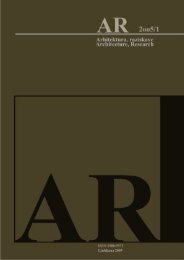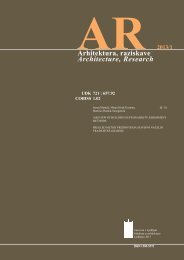AR 2010/1 - Fakulteta za arhitekturo - Univerza v Ljubljani
AR 2010/1 - Fakulteta za arhitekturo - Univerza v Ljubljani
AR 2010/1 - Fakulteta za arhitekturo - Univerza v Ljubljani
Create successful ePaper yourself
Turn your PDF publications into a flip-book with our unique Google optimized e-Paper software.
<strong>AR</strong> <strong>2010</strong> / 1<br />
<strong>AR</strong> <strong>2010</strong>/1<br />
Domen Zupančič<br />
ECONOMY AND COMMON SENSE: SIMPLE<br />
SOLUTIONS FROM PAST FOR TODAY AND<br />
BEYOND<br />
Mediterra 2009, 1 st Mediternean Conference on Earth<br />
Architecture<br />
DiArch Facolta di Architectura, Italy<br />
Escola Superior Gallaecia, Portugal<br />
CRATerre-Ecole Nationale Superieure d’Architecture de<br />
Grenoble, France<br />
13. – 16. marec 2009, Sardinija, Italija<br />
http://www.uni-terra.org/events/mediterra-2009<br />
Mediterra 2009 je bila prva mednarodna konferenca, kjer<br />
smo se srečali raziskovalci glinene arhitekture (eng. earthen<br />
architecture), graditelji, konservatorji in drugi. V štirih dneh je<br />
bilo predstavljenih preko 45 referatov na temo gline, arhitekture,<br />
ekonomije, upravljana, raziskav gradiv. Konferenca je bila<br />
organizirana na pobudo treh organi<strong>za</strong>cij (fakultete in inštitut).<br />
Referati so bili strnjeni v zborniku.<br />
Izvleček<br />
The builder used constructing material due to rational reasons:<br />
source at hand with short delivery pathways; nature of material<br />
is verified from forefathers; handling with material is imparted<br />
through childhood. The last one has the most significant role in<br />
vernacular architecture. Why? In childhood way of thinking and<br />
solving problems are raised. Sincere constructional solutions<br />
in architecture are result of logic and local knowledge. Local<br />
knowledge may be concerned as variable resulting variances of<br />
solutions of the same problem - clay ceiling in Egypt and Yemen.<br />
The following paper shows how solutions from nowadays have<br />
origin in “past” architecture. Smart materials using low tech, with<br />
no artificial energy have much in common with smart materials<br />
“invented” in modern age. Clay and pine tree branch has much<br />
in common with reinforced concrete; soft soil and straw has<br />
much in common with fibreglass flooring; thin gypsum layers<br />
covering rammed earth may extent life span of construction as<br />
thin façade coating protect insulation from decay.<br />
ZUPANČIČ, Domen. Economy and common sense simple<br />
solutions from past for today and beyond. V: ACHENZA,<br />
Maddalena (ur.), CORREIA, Mariana (ur.), GUILLAUD,<br />
Hubert (ur.). Mediterra 2009, (Architettura sostenibile<br />
/ documenti). 1a ed. Monfalcone: EdicomEdizioni, cop.<br />
2009, str. 537-547, ilustr. ISBN 978-88-86729-95-6.<br />
Tadeja Zupančič<br />
COMMUNICATING (BY) CURRICULUM<br />
DESIGN: THE INTEGRAL TRADITION<br />
ON DOCTORAL SCHOL<strong>AR</strong>SHIP IN<br />
<strong>AR</strong>CHITECTURE<br />
Communicating (by) Design<br />
Chalmers University of Technology<br />
15. – 17. april 2009, Göteborg<br />
Izvleček<br />
The intensive programmes offer an opportunity to introduce<br />
fast changing and developing fields into the experience of<br />
architectural students regardless of the flexibility level of<br />
curricular structures and institutional contexts. The main aim is<br />
to enhance and promote place-sensitive interventions in physical<br />
and virtual worlds. The paper concludes with a discussion of<br />
intentions, experience gained, some sobering moments as well<br />
as the learning curves of participants and organizers when it<br />
comes to design culmination of sensitive physical and virtual<br />
realities.<br />
ZUPANČIČ-STROJAN, Tadeja. Communicating (by) curriculum<br />
design : the integral tradition on doctoral scholarship in<br />
architecture. V: VERBEKE, Johan (ur.), JAKIMOWICZ, Adam<br />
(ur.). Communicating (by) design : proceedings of the colloquium<br />
"Communicating (by) Design" at Sint-Lucas Brussels from<br />
15th - 17th April 2009. Brussels: Hogeschool voor Wetenschap<br />
& Kunst; Gent: School of Architecture Sint-Lucas; Göteborg:<br />
Chalmers University of Technology, 2009, str. 675-685, ilustr.<br />
[COBISS.SI-ID 2279812]<br />
Tadeja Zupančič<br />
Matevž Juvančič<br />
VIRTUAL SPACE DESIGN : A FLEXIBLE<br />
LE<strong>AR</strong>NING MODEL<br />
27th Conference on Education and Research in Computer<br />
Aided Architectural Design in Europe<br />
Yildiz Technical University<br />
16.-19. september 2009, Istanbul, Turkey<br />
Izvleček<br />
Studies on ‘the Unthinkable Doctorate’, focused on the<br />
development of doctoral scholarship in architecture, have shown<br />
three types of scientific research approaches: ‘conservative’,<br />
‘pragmatic’ and ‘liberal’. The aim of this contribution is to<br />
indicate that the integration of all the three ‘perspectives’<br />
is possible even within the ‘conservative’ complex larger<br />
institutions (institutional contexts). This can be explained through<br />
the discussions and the results of the recent curricular Bologna<br />
renewal endeavours in Ljubljana/Slovenia: communicating (by)<br />
curriculum design. Identifying its own research tradition, to be<br />
continued and enhanced.<br />
86

















